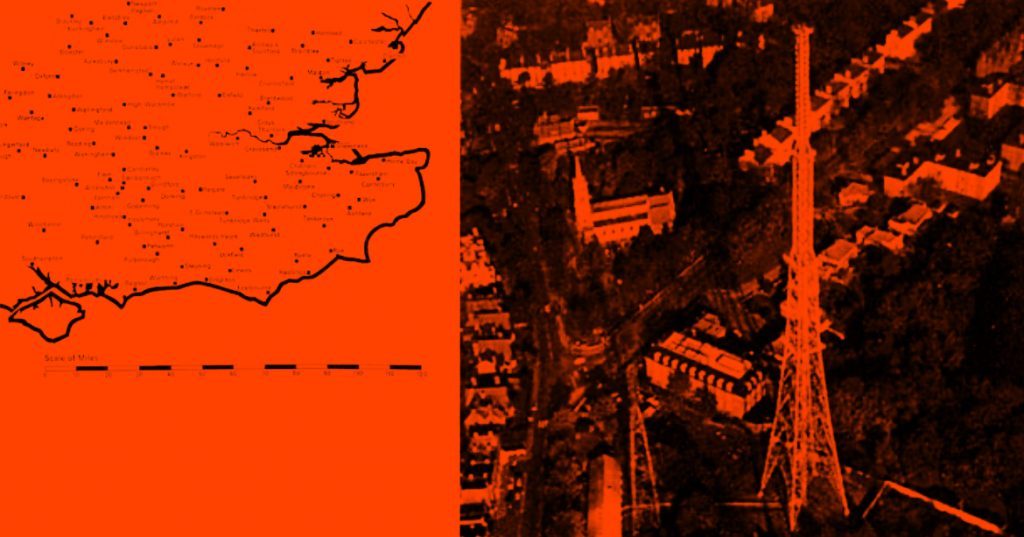Croydon Transmitter, Channel 9
London’s ITV transmitter in 1968

The ITA YEARBOOK for 1968 (pages 136-7) included an article on the ITA’s ‘Croydon’ transmitter, which at the time radiated 405-line transmissions from Rediffusion and ATV to London.

| Croydon Transmitter Facts | |
|---|---|
| Programme Companies | Rediffusion Television (weekdays)
ATV Network (weekends) |
| Population (within measured contours) | Primary 10.91 million.
Secondary 1.98 million. Fringe 0.60 million. Total 13.49 million |
| Channel | Band III Channel 9 (vertically polarised) |
| Vision Carrier Frequency | Nominal 194.75 Mc/s.
Actual 194.75675 Mc/s |
| Sound Carrier Frequency | Nominal 191.25 Mc/s. Actual 191.266 Mc/s |
| Effective Radiated Power (ERP) | Vision 400kW maximum.
Sound 100kW maximum |
| Transmitter Power | Vision (peak white) 10kW.
Sound (carrier) 2.5kW |
| Height Above Sea Level | Site 375ft. Mean aerial 825ft. |
| Location | 0 degrees, 5 minutes 15 seconds West; 51 degrees, 24′ 35″ North |
The Authority’s station on South Norwood Hill near Croydon serves 13.5 million people in the London area, nearly a quarter of the population of the United Kingdom.

The London area is relatively flat except for the North Downs some twenty-five miles to the south and the ridge of the Chiltern Hills some thirty miles to the west and north.
Topographically it presents no serious transmission problems; indeed, the difficulty is to find high ground close enough to the centre of London on which to construct a station. The choice rests between the 400ft ridges of Muswell Hill (Alexandra Palace) in North London and Crystal Palace in South-East London. In 1935 the BBC had chosen Alexandra Palace as the site for its original London television station, but twenty years later they moved to a new station at Crystal Palace. In the interests of good planning the Authority decided to locate its first station near this site.
A suitable open space for the construction of a small compact station which could be brought into operation with the least delay was found just a mile away on South Norwood Hill. The single 10kW transmitter, the first Band III set constructed in this country, was a laboratory prototype. The aerial was an experimental 8-stack omni-directional vertically polarized array, supported on a 200ft tower of virtually ‘stock’ design.

The first Independent Television programmes were transmitted from this station on 22nd September 1955. With an effective radiated power (e.r.p.) of 60kW (peak white vision) and 15kW (carrier sound), the potential population coverage was about 11 million. After some months a second fully-engineered production 10kW transmitter was installed as a standby, and a little later further equipment was installed to enable both sets of transmitters to be operated in parallel in order to double the station’s power.
In due course the Croydon station would have to be given a higher tower and a new aerial system with directional characteristics tailored to give the optimum performance. Meanwhile engineering effort was devoted to expanding the ITA network of stations to meet the fast-growing public demand for Independent Television programmes in other parts of the country.
The completion of the BBC’s 640ft high tower at Crystal Palace allayed any fears that the mutual reflection of signals radiated from the two towers just a mile apart might be harmful to reception, and in February 1959 the ITA obtained Government approval to erect a higher tower and directional aerial at the Croydon site.
By the end of 1962 Croydon was transmitting from its slim new 500ft tower and radiating an effective power of about 400kW directed to the north-west, with 50 to 250kW e.r.p. in other directions, the strength of signal being determined by the requirements of topography and the avoidance of co-channel interference with other ITA stations and television services of other countries.

The improved performance of the Croydon station in 1962 extended the ITA’s London area coverage to include a population of 13.5 million (see coverage map).
The Authority is a present considering plans for a new station building and the replacement of the transmitters at Croydon.
About Effective Radiated Power (ERP)
How can a transmitter producing a maximum of 10kW boast an “effective radiated power” of 400kW? Is this ITA’s engineers boasting? No: when a transmitter has a special directional antenna as was the case here, or any antenna which has more gain than a basic half-wave ‘dipole’ aerial, a smaller transmitter can behave like a much more powerful one. So within the service area, the Croydon 10kW vision transmitter gave the same signal strength to a given viewer’s receiver as a 400kW one would have done if it had a basic, non-directional transmitting aerial. A more technical definition: 1. The power supplied to an antenna multiplied by the antenna gain in a given direction. The type of reference antenna must be specified. 2. The product of the power supplied to the antenna and its gain relative to a half-wave dipole in a given direction. Note: If the direction is not specified, the direction of maximum gain is assumed.



